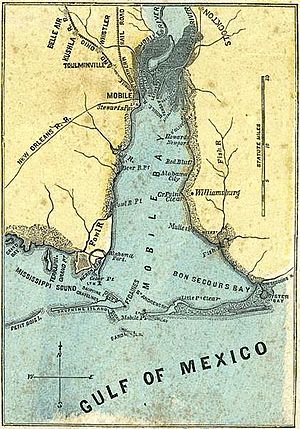Mobile, Alabama, in the American Civil War facts for kids
Mobile, Alabama, was a very important port city for the Southern states (the Confederacy) during the American Civil War. It was located on the Gulf of Mexico. The city was captured by the Union Army late in the war. This happened after the Union Navy successfully attacked the forts protecting Mobile Bay.
Contents
Mobile at the Start of the War
Before the Civil War began, Mobile had grown a lot. The Southern states, called the Confederacy, built strong defenses around the city. In 1860, Mobile had almost 30,000 people. This made it the 27th largest city in the United States. When the Southern states left the U.S. to form the Confederacy, Mobile became their 4th largest city.
In 1860, most people in Mobile were white (69%). About 3% were free Black people, and 28% were enslaved people. One person described Mobile in 1861 as a city with many nice homes. These homes were surrounded by trees like tall pines and oak trees.
Military Actions in Mobile
When the war started, many men in Mobile were excited to join the fight. Hundreds of men signed up for the Confederate army. Old local military groups, called militias, also volunteered. Groups like the Creole Guard and the Southern Guard helped defend Mobile. The Mobile Cadets and Pelham Cadets also served in the city and other parts of Alabama.
The Confederacy needed warships, and Mobile's shipbuilders quickly built them. They made ships like the CSS Gaines and the CSS Morgan. These ships were made of wood but had some armor plating.
Early in the war, the Union Navy started a blockade around Mobile. This meant Union ships tried to stop goods from coming in or out of the port. To get around this, the Confederates built "blockade runners." These were fast, small ships that could try to outrun or sneak past the Union ships. This helped keep some trade going in and out of Mobile.
The CSS Hunley was a very special submarine. It was the first submarine to sink an enemy ship in battle. It was built and tested in Mobile before being sent to Charleston, South Carolina. In July 1863, the Hunley successfully attacked a coal boat in Mobile Bay. This showed that submarines could be useful in war.
Mobile also had several hospitals for wounded and sick soldiers during the war. The Mobile City Hospital treated many civilians who got sick from diseases like yellow fever. The Marine Hospital cared for Confederate soldiers. Later in the war, it also treated Union soldiers.
Life for Civilians in Mobile
Life was hard for people in Mobile during the war. Food and other important items became scarce. This was because the Union blockade made it difficult to get supplies. In April 1863, some angry citizens protested because they needed food for their families. This protest was short, but people remained unhappy.
In September, more than 100 women gathered on Spring Hill Road. Some carried signs that said "Bread or Blood" or "Bread and Peace." Some even carried brooms or axes. They marched down Dauphin Street, demanding food. A local militia was called to stop them, but the soldiers refused to act. They felt sympathy for the women. The women reached the mayor's office and demanded help. The mayor promised to get them food, and the women went home.
The Fall of Mobile
In August 1864, Union Navy Admiral David Farragut led his warships into Mobile Bay. They fought their way past two forts, Fort Gaines and Fort Morgan. They also defeated a small group of Confederate gunboats and an ironclad ship called the CSS Tennessee. This battle is where Farragut supposedly said his famous line, "Damn the torpedoes, full speed ahead!"
The Union victory in Mobile Bay did not make the city of Mobile surrender right away. However, it did stop all ships from getting in or out of Mobile Bay. This ended the blockade runner traffic.
On April 12, 1865, the city of Mobile surrendered to the Union army. This happened three days after Confederate General Robert E. Lee surrendered at Appomattox Courthouse. Mobile surrendered to avoid being destroyed after the Union won battles at Spanish Fort and Fort Blakeley.
Sadly, on May 25, 1865, about 300 people in Mobile died. This happened when a federal ammunition storage area exploded on Beauregard Street. The explosion left a 30-foot deep hole. It also sank ships in the Mobile River and caused fires that destroyed the northern part of the city.
Important People from Mobile
Many important people from Mobile played a role in the Civil War.
- Raphael Semmes was a Rear Admiral. Before the war, he was a lawyer in Mobile.
- Zachariah C. Deas was a Brigadier General. He was a merchant in Mobile. His soldiers fought bravely at the Battle of Chickamauga.
- Augusta Jane Evans was a writer from Mobile. She strongly supported the Southern states. During the war, she helped care for sick and wounded Confederate soldiers. She also wrote patriotic speeches and set up a hospital. Her famous novel, Macaria, promoted Southern values and a desire for an independent Southern culture.
- Robert H. Slough was the mayor of Mobile for most of the Civil War, from 1862 to 1865.
- Dr. Josiah C. Nott was a doctor in Mobile who studied diseases like yellow fever. During the war, he was a surgeon in the Confederate Army. He was in charge of checking military hospitals in Mobile. Two of his sons died fighting in the war.


